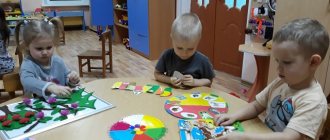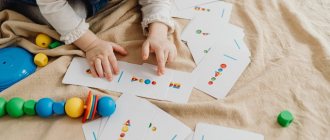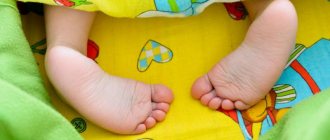Methodical manual “Do-it-yourself sensory toys”
Author:
Taut Irina Petrovna
teacher
MAU DO "Sorokinsky"
child development center - kindergarten No. 1"
The main content of the play of younger preschoolers is actions with toys and substitute objects. Children especially love to play with household objects such as sand, water, various jars, and bottles. Such activities contribute to the development of the child’s sensory system: vision, hearing, smell, taste. If a child receives a rich sensory experience in early childhood, this will help him feel much more comfortable in the future, in adulthood, and will also help him learn successfully. Now many manufacturers have begun to produce wonderful toys for children. These include educational rugs, soft books, sewn puzzles or laces. However, you can make an interesting educational toy with your own hands. Self-made sensory toys carry a charge of positive energy, warmth and tenderness of the hands, and are unique. While working with young children, I noticed that there was a need for the development of fine motor skills, so I had the idea to create a series of toys for sensory development using improvised materials. A variety of items were used: hooks, buttons, laces, Velcro and other improvised materials that can be found in any home. I was looking for various options for educational mats and tablet modules. In general, we got good benefits with a minimum of financial costs. The parents of my students provided a lot of help in making crafts. Together we sewed, glued, nailed, created, invented.
The purpose of these benefits is to develop the sensory abilities of young children, memory, thinking, imagination, develop hand motor skills, and tactile sensations.
The manuals contain tasks and exercises for sensory development, fine motor skills of the hands, speech, logical thinking, imagination, and creative abilities of the child.
All exercises are easy to perform. Their regular repetition contributes to the development of gross, fine and articulatory motor skills, dexterity and coordination of movements. It has a beneficial effect on the development of logical thinking, attention, and memory.
The aids are easy to use; they can be played by one or several children at once in any space, both in a group and on a walk.
Touch cube
Purpose of the manual: To develop children's sensory abilities, speech, attention, imagination, memory, fine motor skills. Form a perception of the quality of objects, teach joint play and interact in a team.
The cube is easy to make, multifunctional, and takes up little space. Several children can play it at the same time. A cube is made from six plastic sink grates, the edges are held together with insulating tape. Inside the cube there are several colored balls of different diameters. A small bell is suspended on the upper edge from the inside.
On each side face on the outside there are various objects for the development of children's sensory abilities. These are ribbons for tying bows, ropes for braiding hair, beads for tactile sensations, Kinder surprise containers with aromatic fillings, small toys, colored clothespins for attaching primary colors.
Mathematical tablet "Geometric"
Purpose of the manual : development of fine motor skills of the fingers, familiarization with geometric shapes. The manual promotes the development of logic, helps to comprehend the basics of geometry, and freely navigate the plane. The manual is made of a wooden board measuring 50x50cm. covered with self-adhesive film. The entire surface is divided into four sectors: yellow, red, blue, green, using power buttons. From 1 to 4 people can play simultaneously. Children are given multi-colored rubber bands with which they depict various geometric shapes: square, triangle, rectangle, oval. The unique technique of “drawing with rubber bands” will give the child the opportunity to feel the shape of geometric shapes with his fingers and teach him to navigate on a plane. Develops attention and perseverance.
Module with locks
Purpose of the manual: An exciting game with locks will help the child develop fine motor skills, learn a lot about the world around him, Promotes the development of arbitrariness, cognitive activity, fine motor skills, ideas about objects and phenomena of the surrounding world, creativity, play activity, memory, combinatorial abilities, abstract thinking. By opening and closing the locks, the child himself can check whether he is doing everything correctly. And if something is wrong, he himself will be able to correct his actions. The implementation of this principle is very important for the development of the child’s independence and his desire to learn. Each door has its own unique lock and color. When opening the door, the child learns to use the closing device (hook, latch, latch) but also sees behind it a picture corresponding to the color of the door. at the bottom of the manual there are various devices for the development of children (socket, switch, calculator). The child learns the purpose of objects, learns to manipulate them, and expands his horizons.
Developmental mat
The purpose of the manual: to develop children's tactile sensations, speech, attention, helps to develop perseverance when working with this rug.
The manual is made from fabrics of different colors and textures. The first row shows different types of fabrics. Children compare fabrics by touch, which is smooth and which is rough and rough.
And in the second row there is faux fur. We compare the length and color of the fur, which animal it belongs to. The third row is presented in the form of a set of geometric shapes. Children learn to name shapes, their colors and their distinctive qualities from each other.
Developmental aid Caterpillar
1 circle of the caterpillar - helps children compare objects by size and color, compare the texture of buttons. Thus developing attention, memory, thinking.
Circle 2 - aimed at developing fine motor skills of the fingers. There are several multi-colored zippers on it, with the help of which children consolidate their knowledge of the colors of objects and develop motor skills of their fingers.
3rd circle of the caterpillar - decorated with a spiral of beads of different colors and shapes (rings, stars, shells, balls) by playing with them, children consolidate their knowledge of color and develop tactile sensations.
4th circle - decorated in the form of houses with a roof. The halves of the houses are connected using hooks and buttons. When children open the doors, a surprise awaits them (residents of the houses). The game is aimed at developing children’s ability to manipulate various types of fasteners (hooks, buttons, Velcro).
Bibliography:
1. Abdullaeva Sh.A. Formation of sensory experience and methods of its organization in young children. Abstract. – M., 1975.
2. Buyanova R. Sensory development of children // Social work. - No. 12. – 2006.
3. Vartan V.P. Sensory development of preschool children. – Mn.: BrGU, 2007.
4. Friedrich Froebel. We will live for the sake of our children / Comp. foreword by A.M. Volumbaeva. – M.: Publishing house “Karapuz”, 2001.
5. Internet resources: https://www.maam.ru/
6.Internet resources: 1september.ru
We invite teachers of preschool education in the Tyumen region, Yamal-Nenets Autonomous Okrug and Khanty-Mansi Autonomous Okrug-Yugra to publish their teaching materials: - Pedagogical experience, original programs, teaching aids, presentations for classes, electronic games; — Personally developed notes and scenarios of educational activities, projects, master classes (including videos), forms of work with families and teachers.
Why is it profitable to publish with us?
1. “Kindergartens of the Tyumen Region” is an officially registered specialized media outlet at the federal level. 2. The activities of the editorial office are supported by the Department of Education and Science of the Tyumen Region 3. We issue a “Certificate of Publication” in the media. 4. The document has a unique number, is entered in the register, has the original seal of the editorial office of the online publication and signature. 5. “Certificate of publication” in the media is sent to the author in both paper and electronic versions.
Details >>>
Sample “Certificate of publication of author’s methodological material in the media.”pdf
Share
Areas of sensory education for children 4-5 years old
In middle preschool age, sensory education is implemented in the following areas:
- Meaningful activity. This activity helps the child focus on individual objects and their characteristics. The child masters the connection between the result of his work and the skills of identifying individual properties of an object, i.e. he understands that if he knows the shape of an object, its spatial location, he can find this object among others and obtain it.
- Educational activities. Sensory development and the formation of sensory representations are impossible without the targeted influence of teachers. They use special methods and techniques that help in productively mastering the properties of objects and training the acquired skills in practice.
- Adult guidance. It is necessary to minimize the preschooler’s mistakes in mastering sensory standards and forming sensory perception. An adult helps the child in sensory exploration of the world and guides him. At the same time, the role of not only the teacher is important, but also the adults who are close to the child: parents or guardians.
What games help develop sensitivity at all levels?
Since I’m in the younger group, I’ll give you my card index, but I’ll try to make additions for different ages. In general, the meaning of such games is this: to give the child a wide range of sensations and knowledge about the properties of objects, substances, phenomena that can be felt tactilely, visually, auditorily and “smelling”. In the same way, these same sensory-didactic, that is, educational games are suitable for young children. It is necessary to select games that are adequate to the child’s age capabilities.
For simplicity, I divided the card index into 5 blocks: the development of visual perception, auditory, olfactory, tactile, as well as games for fine motor skills and purposeful actions.
I will not describe absolutely all the components of the card index, and it would be stupid to list them without a description, because you can’t always understand the essence by the name, so I will give a description of the most effective games for sensory development. You will see how simple, interesting and useful it is to amuse your baby and teach at the same time!
So, 1 block of didactic games for training visual sensitivity:
- “Lids and boxes”: you can take empty plastic jars with gouache lids, they are usually multi-colored. Place cards inside to match the color of the box. For older children, you can place beads or other small objects in monochrome colors.
Objectives: we train the ability to correlate colors, find identical ones, analyze and systematize. At the same time, we train motor skills, learning to open lids. We exercise the ability to distinguish shape and size. If you shake a jar with a card inside, you will also train your hearing.
Believe me, if you complicate the task, the middle and older groups will be interested in this game. For them, you can add shades of colors, place inside a card with a picture that is not monochrome, but made predominantly of one color. We select lids with threads to make it more difficult to open.
- “Vegetable Garden” is a game for the development of sensory standards. We take small square cardboards, draw the outline of a fruit or vegetable on them and cut out the middle. Separately, we have cardboard boxes of the same size, but completely painted over, matched to the colors of the prepared fruits and vegetables. Task: find its color for each fruit and place the blank on top of the corresponding colored cardboard.
Didactic games for the development of auditory perception: 2nd block
- To organize this type of game, waste material is suitable. For example: “Colorful noisemakers.” We take plastic bottles and glue labels of different colors to them, but of the same color. We will stir anything inside, as long as it fits into the neck and is matched to the color of the label: dyed legumes, cereals, beads, sand. The baby shakes these noisemakers, now stronger, now weaker, catching the difference in the sounds made.
At the same time, we will train our visual perception of color and motor skills. Children aged 2-3 years love this game. In the second junior group, and even in the first junior group, this fun is a great success. Apparently, babies still miss rattles...
And to make the fun more interesting in the 1st junior group, you can decorate the noisemakers in the form of toys: take a plastic Kinder egg, put different objects inside (cereals, a ball, whatever), cover them with fabric or crochet them, creating chickens, for example. Each chick will make different noises.
The preparatory group can complicate the task: pour the contents of the bottles into separate boxes and then again select the filling required for each specific bottle by color. In addition, if you shake bottles consciously, you develop a sense of rhythm, and this is an ear for music!
- "Who's making noise?" – goes well in the middle group. Behind the child’s back, we make characteristic sounds using any objects: rustling the pages of a book, knocking something on the table, etc. The child must guess what makes the sounds. Great ear training!
Block 3: developing the sense of smell...
There is no need to go far here; the games smoothly move into the kitchen. The average group can cope with this task quite well:
- “Guess what the chick will eat?” – the child plays the role of a hungry chick, and someone else imagines himself as a mother bird who has flown in to feed her young. But the mother is cunning: the chick must first guess by the smell what the mother brought him. We bring the child a piece of something edible and let him inhale the aroma. This is very interesting for older children, but the 2nd younger group can also try to guess.
- Older preschoolers will enjoy competing in the game “What does it smell like?” The idea is this: we make small bags of gauze in advance, and immediately before the game we place pieces of food with a characteristic aroma into the bags: citrus fruits, coffee beans, onions, garlic, apples, etc. Again, the baby guesses what’s inside.
Now the expanse of fruits, the preparatory group and younger preschoolers can train a more subtle sense of smell, let them learn to distinguish the smells of vegetables and fruits with a weakly expressed aroma.
Despite the simplicity of such didactic games, they are of great benefit. Through play, the child receives full sensory education and enriches the world of his sensations. And this already develops the brain as a whole. Moreover, our vocabulary is also enriched, because we learn new words.
4th block: enriching tactile sensations
- “Surprise”: place a deep container with sand, cereals, etc., in which objects are hidden. The child finds it, rejoices and at the same time develops the sensitivity of his fingers.
- “Hello!”: we make blanks in advance from materials of different textures, gluing them onto cardboard and cutting out palms. The child puts his palm on the workpiece, feels the texture, learns new concepts: smooth, rough, soft, fluffy.
- “Sinking or not sinking”: we take a container with water and in another container - different objects that can be soaked in water. The child explores which objects sink and which do not, and tries to guess in advance the possibility of floating on the water.
To develop tactile sensations, you can use everything you see around the house while walking. Yes, the child trains himself, feeling everything that comes to hand. But it is imperative to focus the baby’s attention on the names of phenomena and sensations. Pay attention to color, shape, size.
What can I say, you have already guessed how useful didactic games for the development of tactile sensations are for little autistic children - autistics, and for all children with mental retardation (mental retardation).
Block No. 5: learning to take purposeful actions
- “We sell cereals”: we pour different types of cereals or sand into bowls, we learn to pour cereals into other containers, as if for a buyer.
- “Treat the doll with candy”: take round plastic round containers with lids and decorate them in the shape of a doll’s head. Glue or draw a face and hair. We cut a small hole in place of the mouth. Separately, we are preparing a box with multi-colored buttons, which will be our candies. You need to push the candy button into the doll’s mouth.
- Exercise machines with laces, Velcro buttons, clasps, etc. work great for educational purposes. At least you need to make a simulator with buttons: sew buttons onto the fabric, stretch the fabric onto plywood or something similar. Separately, we make blanks with loops for buttons, for example, these are flower petals that need to be attached to a button and made into a flower.
Even the descriptions of several games took up a lot of space on the blog page. I suggest just buying special literature and making your own card index of didactic games.
So, manuals from UchMag:
- “Sensory development of young children. 1-3 years." While the book is out of stock, you can always leave a request for a missing item on this website;
- “Sensory development of children 2-3 years old. Color. Form. Size” – here are presented didactic games and exercises for organizing joint activities between the teacher and young children;
- “Sensory development of children 3-4 years old. Color. Form. Size" - the same for younger preschool age;
- “Sensory development of children 4-5 years old. Color. Form. Size” – respectively, average preschool age;
- “Sensory development of children 5-6 years old. Color. Form. Size” – materials for the older group;
- “Sensory development of children 6-7 years old. Color. Form. Size" - for the preparatory group.
Middle group. Junior preschool age. Children 4 - 5 years old
Card index of didactic games on sensory education for children of primary preschool age Prepared by: teacher of MBDOU kindergarten No. 32 Bykova A.V. A child’s sensory development is the development of his perception and the formation of ideas about the external properties of objects: their shape, color, size, position in space, as well as smell and taste. The importance of sensory development in...
Summary of the parent meeting "Didactic games as a means of sensory development of children of primary preschool age" Game workshop "Journey to the country of Sensory "
Goal: enriching parental ideas about
the sensory development of children of early preschool age. Objectives: to introduce parents to didactic games that promote children’s sensory development , aimed at…




